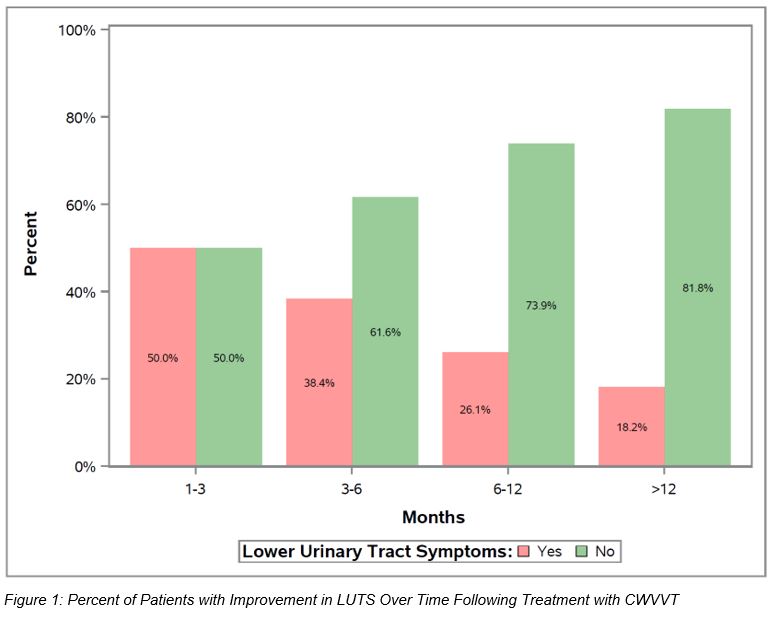Back
Poster, Podium & Video Sessions
Best Poster Award
MP01: Benign Prostatic Hyperplasia: Surgical Therapy & New Technology I
MP01-09: Risk Factors for A Delayed Improvement in Lower Urinary Tract Symptoms Following Convective Water Vapor Thermal Therapy
Friday, May 13, 2022
7:00 AM – 8:15 AM
Location: Room 228
Sarang Janakiraman*, Michael Felice, Aya Bsatee, Gaurav Pahouja, Kevin T. McVary, Maywood, IL
- SJ
Sarang Janakiraman, BA
Loyola University Chicago Stritch School of Medicine
Poster Presenter(s)
Introduction: Convective water vapor thermal therapy (CWVTT) is a minimally invasive surgical therapy (MIST) for LUTS/BPH that has been shown to produce clinically significant results up to 5 years. We aimed to identify the incidence and risk factors for delayed improvement in LUTS and retreatment following CWVTT in men with LUTS/BPH.
Methods: Patients who underwent CWVTT from 1/2018 to 12/2020, at a single institution, were identified by CPT code. Pertinent patient, treatment, and outcomes data were extracted. Pressure flow studies were done in 73% of eligible patients. Patients missing pre- or immediate post- operative International Prostate Symptom Score (IPSS) were excluded. Delayed LUTS improvement was defined as failure to reach a minimally important clinical difference (MCID) of 25% on the IPSS after 4 weeks following CWVTT. Potential risk factors of delayed LUTS improvement were assessed by logistic regression.
Results: 109 patients were qualified for analysis. 50% of patients experienced delayed LUTS improvement (failure to reach MCID at 4 weeks), although, 82% of men reached the MCID by 12 months. Time from CWVTT, bladder outlet obstruction index (BOOI), and prior surgical BPH therapy were associated with delayed LUTS improvement on multivariate logistic regression. For each additional month following CWVTT, the odds of achieving MCID in LUTS increases by 9% (OR=0.91, 95% CI 0.86-0.97, p=.003). Every 10-unit increase in BOOI was associated with a 15% chance increase in achieving MCID in LUTS at 4 weeks following CWVTT (OR=0.85, 95% CI 0.75-0.96 , p=.01). Patients receiving prior surgical BPH therapy were 3.5 times more likely to experience a delayed improvement in LUTS (OR=3.47, 95% CI 1.36-8.90 , p=.01).
Conclusions: 50% of men undergoing CWVTT experienced delayed LUTS improvement (failure to reach MCID at 4 weeks). The odds of reaching a MCID increases by 9% with each subsequent month. Men with a high BOOI indicative of more severe obstruction are more likely to reach the MCID. Men with failed prior BPH surgery are at risk of failing to reach MCID.
Source of Funding: None

Methods: Patients who underwent CWVTT from 1/2018 to 12/2020, at a single institution, were identified by CPT code. Pertinent patient, treatment, and outcomes data were extracted. Pressure flow studies were done in 73% of eligible patients. Patients missing pre- or immediate post- operative International Prostate Symptom Score (IPSS) were excluded. Delayed LUTS improvement was defined as failure to reach a minimally important clinical difference (MCID) of 25% on the IPSS after 4 weeks following CWVTT. Potential risk factors of delayed LUTS improvement were assessed by logistic regression.
Results: 109 patients were qualified for analysis. 50% of patients experienced delayed LUTS improvement (failure to reach MCID at 4 weeks), although, 82% of men reached the MCID by 12 months. Time from CWVTT, bladder outlet obstruction index (BOOI), and prior surgical BPH therapy were associated with delayed LUTS improvement on multivariate logistic regression. For each additional month following CWVTT, the odds of achieving MCID in LUTS increases by 9% (OR=0.91, 95% CI 0.86-0.97, p=.003). Every 10-unit increase in BOOI was associated with a 15% chance increase in achieving MCID in LUTS at 4 weeks following CWVTT (OR=0.85, 95% CI 0.75-0.96 , p=.01). Patients receiving prior surgical BPH therapy were 3.5 times more likely to experience a delayed improvement in LUTS (OR=3.47, 95% CI 1.36-8.90 , p=.01).
Conclusions: 50% of men undergoing CWVTT experienced delayed LUTS improvement (failure to reach MCID at 4 weeks). The odds of reaching a MCID increases by 9% with each subsequent month. Men with a high BOOI indicative of more severe obstruction are more likely to reach the MCID. Men with failed prior BPH surgery are at risk of failing to reach MCID.
Source of Funding: None

.jpg)
.jpg)